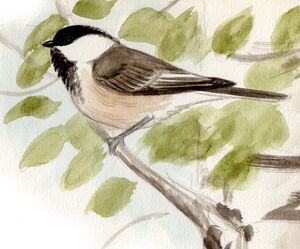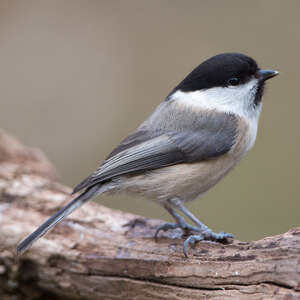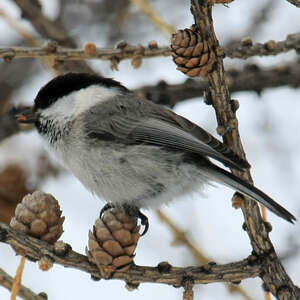Willow Tit
Poecile montanus - Mésange boréale
Identification
The Willow Tit group consists of two species in our area that are similar in appearance and can be confused, the Blue Tits and Willow Tits. We will consider the identifications in regards to the two taxa. As often, voice is the best distinguishing criterion. This will be discussed in the next chapter.
The Willow Tit has 14 subspecies that have quite pronounced plumage differences. Therefore, we will focus on the one that concerns us in France on the plains, the ssp rhenanus.
[In brackets is the counterpart with the Blue Tit].
The head has a black cap that covers the black eye and continues onto the nape. In the adult, this black is matte [shiny black, like it's been polished]. The sides of the head, from the beak to the nape, are white [a line is often quite clearly separates the white cheeks from the back reddish]. A often widened and ill-defined black moustache occupies the chin [small, well-defined moustache]. The throat is white. The beak is completely black [with a small pale patch at the corner]. The upper parts of the body and the wing covers are of a brown shaded with grey, quite dark and cold [slightly more clear]. The lower parts are hued reddish, especially around the wrists and the sides [less ruddy lower parts]. The remiges and rectrixes are blackish with faint pale edgings, these widened and forming a clearly marked brighter area on the closed wing secondaries [no brighter area on the secondaries]. The legs are grey.
Finally, a criterion for the ringers that cannot be appreciated until the bird has been handled, the tip of the tail. It is quite rounded for the Willow Tit, with more than 4 mm between the central and the external rectrices [slightly rounded, less than 4 mm].
The nominal subspecies montanus of the Jura and the Alps is generally paler and grayer.Young birds can be confusing. Indeed, the sides of the head may be tinged with a chamois color, the bib less visible, the lower parts paler, and the corner of the beak also paler. Suffice it to say they can be confused with the Willow Tit. So it is important to pay attention to the cries.
Subspecific information 14 subspecies
- Poecile montanus montanus (se France to Romania, Bulgaria and Greece)
- Poecile montanus kleinschmidti (Britain)
- Poecile montanus rhenanus (nw France to w Germany, n Switzerland and n Italy)
- Poecile montanus salicarius (Germany and w Poland to ne Switzerland and Austria)
- Poecile montanus borealis (Scandinavia s to Ukraine)
- Poecile montanus uralensis (se European Russia, w Siberia and Kazakhstan)
- Poecile montanus baicalensis (ec and e Siberia, n Mongolia, n China and n Korea)
- Poecile montanus anadyrensis (ne Siberia)
- Poecile montanus kamtschatkensis (Kamchatka Pen. and n Kuril Is.)
- Poecile montanus sachalinensis (Sakhalin I. and s Kuril Is.)
- Poecile montanus restrictus (Japan)
- Poecile montanus songarus (se Kazakhstan to Kyrgyzstan and nw China)
- Poecile montanus affinis (nc China)
- Poecile montanus stoetzneri (ne China)
Foreign names
- Mésange boréale,
- Carbonero montano,
- chapim-montês,
- Weidenmeise,
- kormosfejű cinege,
- Matkop,
- Cincia alpestre,
- talltita,
- Granmeis,
- sýkorka čiernohlavá,
- sýkora lužní,
- Fyrremejse,
- hömötiainen,
- mallerenga capnegra,
- Votmeisa,
- czarnogłówka (zwyczajna),
- pelēkā zīlīte,
- gorska sinica,
- Пухляк,
- コガラ,
- 褐头山雀,
- talltita,
- 褐頭山雀,
Voice song and call
The voice is essential to confirm an identification. The calls are varied and reminiscent of those of the [Willow Tit], but some are typical. One can note psit, sit, pit, sitiu, sitiu dé dé dé dé, tsidé, piu piu piu,... . The most typical is a sit sit tjé tjé tjé with the last syllables nasal and of much lower tone. The song, very typical consists of the repetition 4 to 5 times of the same note, tsiu tsiu tsiu tsiu tsiu.
Habitat
We will only consider the habitats of the two subspecies present in France.
The northern plains birds (rhenanus) search for old formations in wetland areas, often near water, old willow, alder, riparian, old poplar, ecotonal deciduous forest/aquatic area, more rarely the forest itself.
The Willow Tit of the Jura and Alps (montanus) occupy coniferous forests and have a different ecology.
Behaviour character trait
The Willow Tit is a sedentary bird, but in winter it is less attached to its territory and more restless. It makes reserves of food that it hides away for the winter. It rarely ventures into gardens, avoiding the company of humans, probably because of lack of suitable habitat. It will only approach a bird feeder if it is located close to a wood.
Dietfeeding habits
Reproduction nesting
The female Willow Tit constructs her nest by chiseling a hole into decaying or dead wood with her beak. She amasses a variety of materials, including wood chips, and lines the nest with grass, feathers, and fur. She lays a clutch of 6-9 white eggs flecked with red and incubates them alone for almost two weeks. The young fledge after about 17-19 days. She raises only one brood per year.
Geographic range
The Willow Tit has a distribution area that spans all Eurasia, from the British Isles to the far east of Russia in temperate and boreal latitudes. 14 subspecies share this huge area. It does not like hot climates, starting with the Mediterranean climate. That's why it is absent from Spain, most of Italy and Greece, Turkey, Central Asia, etc. On the contrary, it stretches as far north as Scandinavia and Siberia.
In France, the ssp rhenanus is found in the plains of the north of the country and the ssp nominale montanus is found in the mountains of the east.
Threats - protection
IUCN conservation status
concern
in the Wild
threatened
evaluated
The species, due to its wide distribution, is not generally threatened. It is demonstrated that the collection of dead wood in wet areas where it rots significantly restricts the possibilities of nesting of the Willow Tit which likes to excavate its nest there.
Sources of information
- IOC World Bird List (v15.1), Gill, F and D Donsker (Eds). 2025-12-07.
- Chickadees, tits , nuthatches and treecreepers, Harrap Simon
- Les passereaux d'Europe, tome 1, P. Géroudet, M. Cuisin
- Birds of the World, The Cornell Lab of Ornithology
- xeno-canto, Sharing bird sounds from around the world,
Other sources of interest
 Specification sheet created on
28/10/2023 by Alexandre Knochel
Specification sheet created on
28/10/2023 by Alexandre Knochel partially rewritten on 00/00/0000 by Jean François
Translation by AI Oiseaux.net
© 1996-2025 Oiseaux.net
- Accipitriformes
- Aegotheliformes
- Anseriformes
- Apodiformes
- Apterygiformes
- Bucerotiformes
- Caprimulgiformes
- Cariamiformes
- Casuariiformes
- Charadriiformes
- Ciconiiformes
- Coliiformes
- Columbiformes
- Coraciiformes
- Cuculiformes
- Eurypygiformes
- Falconiformes
- Galliformes
- Gaviiformes
- Gruiformes
- Leptosomiformes
- Mesitornithiformes
- Musophagiformes
- Nyctibiiformes
- Opisthocomiformes
- Otidiformes
- Passeriformes
- Pelecaniformes
- Phaethontiformes
- Phoenicopteriformes
- Piciformes
- Podargiformes
- Podicipediformes
- Procellariiformes
- Psittaciformes
- Pterocliformes
- Rheiformes
- Sphenisciformes
- Steatornithiformes
- Strigiformes
- Struthioniformes
- Suliformes
- Tinamiformes
- Trogoniformes































